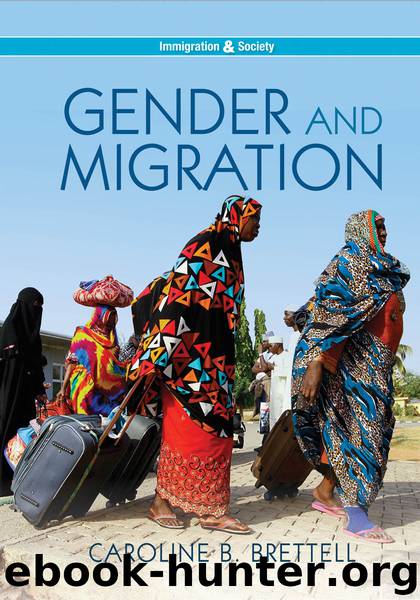Gender and Migration by Brettell Caroline B.;

Author:Brettell, Caroline B.; [Brettell, Caroline B]
Language: eng
Format: epub
Publisher: Polity Press
Published: 2016-09-12T00:00:00+00:00
The Gendered Labor Market of Male Immigrants
So far the discussion in this chapter has focused on the gendered labor market from the perspective of female immigrants, with only minimal references to their male counterparts. But there are equally labor recruitment programs as well as sectors of both the formal and informal economy that largely attract men. One arena is in landscape maintenance and grounds-keeping. Sociologists Ramirez and Hondagneu-Sotelo (2009: 72), based on research in Los Angeles, observe that while in 1980 there were 8,000 Mexican foreign-born men who were working as gardeners in the Los Angeles-Long Beach metropolitan area, by 1990 there were almost 20,000 and by 2000 there were over 30,000. These authors pose the question of whether the teams of Mexican men whom one sees in US suburban neighborhoods every day, mowing lawns and blowing leaves, are workers in low-wage, dead-end, and dirty occupations or small and autonomous entrepreneurs who are building a business. They are both; some of them, these researchers note, following in the footsteps of Japanese-American gardeners during an earlier phase of immigration who made landscape gardening into a legitimate occupational niche because they were racially excluded from other forms of employment. As with women’s domestic work, social networks are important to this masculinized labor sector and these immigrant men are now doing the work that once used to be performed by fathers and sons in a household.
Those working in this industry can be broken down into three occupational categories – waged employers (ayudantes/helpers); independent, self-employed route owners who own their own trucks and equipment and who have a roster of residential customers for whom they provide landscape services; and licensed landscape contractors (Ramirez and Hondagneu-Sotelo 2009: 77). There is occupational mobility within the sector depending on the development of social and financial capital as well as legal status.
By strategically managing their routes, and by working long hours and six and seven day workweeks, some Mexican immigrant gardeners earn six figure incomes. Few occupations in the contemporary, postindustrial service economy offer Mexican men with less than a primary school education and limited English fluency this opportunity.
(Ramirez and Hondagneu-Sotelo 2009: 85)
Download
This site does not store any files on its server. We only index and link to content provided by other sites. Please contact the content providers to delete copyright contents if any and email us, we'll remove relevant links or contents immediately.
Cecilia; Or, Memoirs of an Heiress — Volume 1 by Fanny Burney(32061)
Cecilia; Or, Memoirs of an Heiress — Volume 3 by Fanny Burney(31456)
Cecilia; Or, Memoirs of an Heiress — Volume 2 by Fanny Burney(31408)
The Great Music City by Andrea Baker(30780)
We're Going to Need More Wine by Gabrielle Union(18631)
All the Missing Girls by Megan Miranda(14726)
Pimp by Iceberg Slim(13777)
Bombshells: Glamour Girls of a Lifetime by Sullivan Steve(13683)
Fifty Shades Freed by E L James(12910)
Talking to Strangers by Malcolm Gladwell(12869)
Norse Mythology by Gaiman Neil(12825)
For the Love of Europe by Rick Steves(11458)
Crazy Rich Asians by Kevin Kwan(8886)
Mindhunter: Inside the FBI's Elite Serial Crime Unit by John E. Douglas & Mark Olshaker(8699)
The Lost Art of Listening by Michael P. Nichols(7159)
Enlightenment Now: The Case for Reason, Science, Humanism, and Progress by Steven Pinker(6871)
The Four Agreements by Don Miguel Ruiz(6316)
Bad Blood by John Carreyrou(6275)
Weapons of Math Destruction by Cathy O'Neil(5829)
